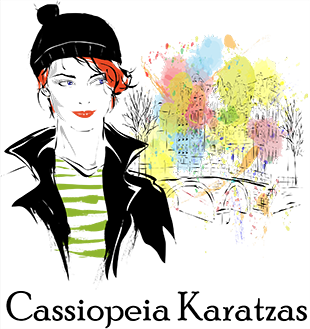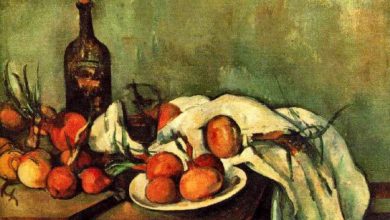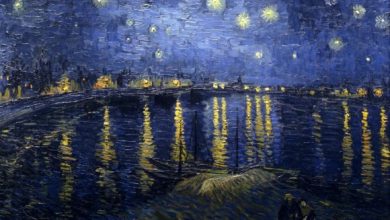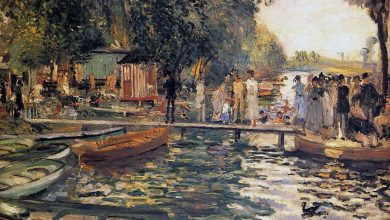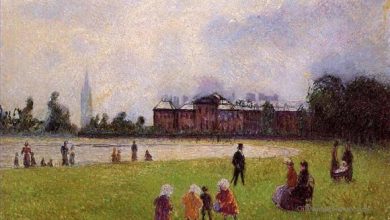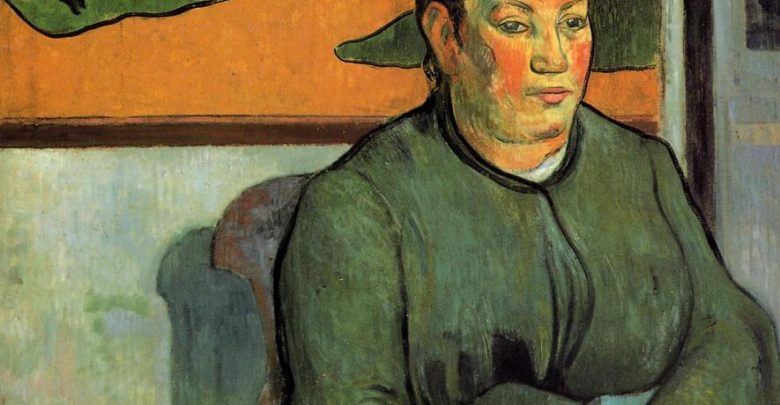
For many, the “myth” of Paul Gauguin—the self-taught artist who abandoned his family to focus full-time on painting in distant places—can overwhelm his actual life story and contributions to art. Apart from his personal story, Gauguin’s innovations—his bold style that expressed emotion through strong color, and his exotic subject matter—had a profound effect on the art of the twentieth century.
French artist Paul Gauguin attempted, through his art and his writing, to answer the question: How can I express my many different sides? He not only drew and painted self-portraits, but he also sculpted images of himself in wood, bronze, and ceramic. Altogether, he made more than 40 self-portraits. Throughout his life, he also wrote letters that give clues to his personality and beliefs.
Originally painted on a wooden door of an inn in northwestern France, this self-portrait is both startling and thought-provoking. Gauguin’s friends called it an unkind character sketch—a caricature. Like a political cartoonist, Gauguin suggests what he looks like, showing only his head and one hand. He fills in the rest of the panel with symbols that appear to deal in opposites: good and evil, heaven and hell. He places expanses of flat, intense color—red and yellow—next to each other. He frames his floating head with stylized, arching green stems and square flowers. Is this the Garden of Eden . . . or . . . ? Is Gauguin telling us he is part angel, part devil? Perhaps he’s showing himself as a sort of magician—an artist with tremendous creative power who can conjure identities through his artistry.
Guided Practice
Brainstorm with students to make a list of the different symbols—both objects and colors—in this painting. If they have an idea what they might symbolize, they should note it also; for example, snake=evil. Here are some they may come up with:
- The snake, held between Gauguin’s fingers, enticed the biblical character Eve to taste the forbidden apple from the Tree of Knowledge. From then on, Adam and Eve had knowledge of good and evil. The snake might symbolize evil and temptation, but might also represent knowledge.
- The halo above Gauguin’s head makes us think of angels and Heaven. Halos signify divinity or saintliness.
- The apple is a symbol from the story of Adam and Eve. When Eve ate the apple from the Tree of Knowledge, it caused humankind’s expulsion from the Garden of Eden.
- The brilliant red background might be a sign of the fires of Hell. It might also symbolize creative energy.
Paul Gauguin
French, 1848–1903
Self-Portrait Dedicated to Carrière, 1888 or 1889
oil on canvas, 46.5 x 38.6 cm (18 5/16 x 15 3/16 in.)
National Gallery of Art, Collection of Mr. and Mrs. Paul Mellon
Is this the same Gauguin? Gauguin painted this more conventional self-portrait (given to fellow artist, Eugène Carrière) around the same time. It focuses on the artist’s head and shoulders—all connected together the way they should be! Gauguin wears a comfortable sweater and jacket and seems relaxed as he looks out at us, without the “evil eye” seen in the other painting. He places himself in a room with a pleasant view of soft mountains through the window—unlike the flat, confusing space of the first self-portrait.
While these two self-portraits differ in many ways, they both show the unusual way Gauguin used color to express emotion and capture the inner self. Draw a Venn diagram on the board to help students compare and contrast these two self-portraits. List their observations of what is unique to one self-portrait in the left circle, and to the other one in the right circle. Then list the things they have in common in the center section.
Some additional discussion points to aid the comparison:
Questions for Self-Portrait:
- Where is this figure?
- Describe his mood. What do you base your response on?
- Talk about the use of color. List the prominent colors and the association they have for you.
- What can you infer about the artist just from looking at this work?
Questions for Self-Portrait for Carrière:
- What/who is this? How do you know?
- Where is this person?
- How does he spend his time, based on what you see here?
- Describe his mood. Use visual elements to support your answer: colors, angle of pose, type of gaze, body language.
- What is his attitude (cocky, jaunty, self-satisfied, dreamy, cranky, self-assured, romantic)?
- What’s happening beyond the window?
- Anything unusual about this work?
Activity
Students will think about the characteristics and qualities that make them “them.” How can they be visually shown? Is it possible to create a self-portrait without even including their face or body? In what other ways can they represent who they are?
Using magazines, students will cut out pictures from magazines that represent or symbolize their personality, talents, tastes, and moods. For example, if they like photography, they might cut out a camera. To show musical talent, they might use instruments, lyrics, or musical notes. If they like to help others, they might include pictures of other people or a hand. Students should use their imagination: look for colors, patterns, places, foods, clothes, and other objects to show “them, ” without really showing “them”! They should think about some less obvious ways to symbolize some of their traits. For example, if they are wise, find a picture of an owl.
Once they have collected their symbols, they should arrange them on background paper or poster board. They may want to paint their background first. Additionally, they can use pencils, markers, or paints to create more symbols.
